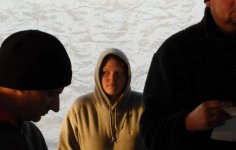aureliaaurita
Well-known
'Stick to what you know', 'write of what you know', could this also extend to simply, 'photograph what you know'?
Whilst I am pleased with the photos I take of people I have a raport with, my family and friends, I can't seem to photograph anyone I don't hold closely or even perhaps friends I secretly dislike or simply 'don't get' (we all have them) that have asked me to photograph them. Something about the images never rings true and I admire people that can draw a stunning portrait from a stranger that has just waltzed into the room, or from those whose character they are at odds with.
I know it's rediculous in a way because it's a technical art but everything I have ever attempted enforces the fact. Perhaps it is merely because I don't feel as comfortable manouevering about them?
In another sense I have also recently tried to attempt 'modelesque' work, but failed. I can't get interested enough. I feel like I am constantly imitating whatever takes my fancy in the latest fashion magazine, and imitating it extremely poorly.
And architectural photos. How on earth do people get witty and original shots of buildings? I had a wander round the maritime museum and royal observatory in london the other day, and to anyone that has been there or seen the golden compass they will know what magnificent buildings they are composed of, the light was perfect, the shadows were perfect, every single one of my photos was boring.
Practise makes perfect, but do you have to have natural inclination to begin with?
Whilst I am pleased with the photos I take of people I have a raport with, my family and friends, I can't seem to photograph anyone I don't hold closely or even perhaps friends I secretly dislike or simply 'don't get' (we all have them) that have asked me to photograph them. Something about the images never rings true and I admire people that can draw a stunning portrait from a stranger that has just waltzed into the room, or from those whose character they are at odds with.
I know it's rediculous in a way because it's a technical art but everything I have ever attempted enforces the fact. Perhaps it is merely because I don't feel as comfortable manouevering about them?
In another sense I have also recently tried to attempt 'modelesque' work, but failed. I can't get interested enough. I feel like I am constantly imitating whatever takes my fancy in the latest fashion magazine, and imitating it extremely poorly.
And architectural photos. How on earth do people get witty and original shots of buildings? I had a wander round the maritime museum and royal observatory in london the other day, and to anyone that has been there or seen the golden compass they will know what magnificent buildings they are composed of, the light was perfect, the shadows were perfect, every single one of my photos was boring.
Practise makes perfect, but do you have to have natural inclination to begin with?
Last edited:


